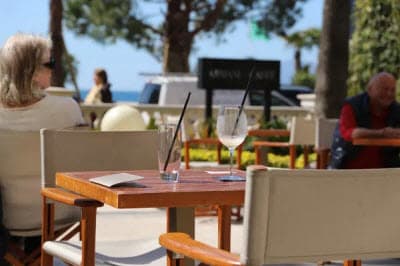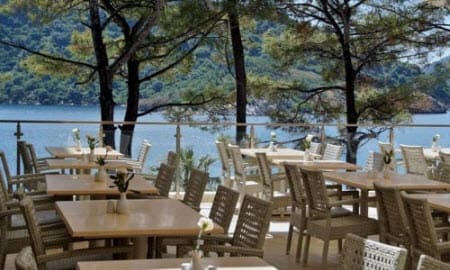If there is one thing diners love more than eating food, it’s eating food outside if/when the weather permits. When done correctly, al fresco dining can be valuable to dining establishments that offer restaurant outdoor seating. It can also be a form of advertisement. After all, your patio is the first area your customers notice. Seating, lighting, location, outdoor restaurant furniture, decorations and signage are just a few areas to consider when opening and/or expanding your outdoor dining area.
Rules for Successful Outdoor Dining

Customer Dining Preferences and Location

The different types of al fresco dining environments are vast and all of them have unique requirements. Is your location practical for restaurant outdoor seating? What can be seen and who can see your patio area are important considerations to make in a location.
Just making seating arrangements to set up patio furniture doesn’t always encourage guests to dine outside. Do your customers prefer to eat outdoors or in a private, quiet indoor space? What is your ideal outdoor location for enjoying a drink or a meal? Vacant patio tables and chairs outside your restaurant may not be the message you want to advertise either.
Logistics and Design Regulations
Outdoor dining areas have some particular aspects that need to be factored into the patio design and layout. Some of these restaurant design and layout regulations are generic to any dining space: placement and space between restaurant tables and chairs to ensure easy flow for both guests and wait staff. Other design facets are specific to outdoor spaces:
- Doorways to the building’s exterior must be easily navigable
- Signage with a simple message Patio Open should be used as an indication to guests that you are open for business
- All items must be carried out and set up for the day and removed into off-street storage at night
- Commercial outdoor furniture, signs, lighting and other decorations can be fixed to the floors or walls
- Items must withstand high winds, especially on uneven floors
- Have sufficient shade and weather protection
- Patio furniture needs to be waterproof, UV resistant, and stackable
- Outdoor heaters and/or fans should be provided
Decorative Components to Use

There are contributing exterior design elements to make your patio space more attractive and inviting to guests. A space decorated with lush foliage is one of them. Just enough greenery will make alfresco dining very enjoyable accompanied with great food and descent weather. This can be easily achieved with pots or growing climbers placed around a pergola. Greenery can enhance your patio’s aesthetics and entice more guests in. Foliage in planters allow for privacy between dining spaces and miniature trees provide a sense of refinement to any terrace.
Lighting design above the patio seating area plays a very important role in drawing customers in. While lighting may be an afterthought in a patio design, it is actually crucial to the ambiance you want to create. Without carefully planning and designing your outdoor dining space, however, you may find some tables inadvertently over-lit in one area and others placed in a dark corner. When it comes to lighting design for your patio, you may want to highlight the architectural features of your restaurant building and illuminate any signage or other decorative elements. Lanterns and string lights create a romantic sense. Outdoor lighting can also be used as a preventative measure to reduce the chances of break-ins and robberies when you are closed.
Outside Restaurant Dining Laws
As with any legally operated business, there are laws and regulations which you are expected to comply with in and out the 4 walls of your restaurant. They may vary by state, however:
- Smoking - there are municipalities that have enacted laws for smoke-free outdoor dining and patio bars and others with restricted smoking to certain areas of outdoor dining spaces. Learn more here
- Pets - dogs (or any pet) are not allowed indoors. Pets are permitted outside the premise of the patio area as long as these requirements are met.
- Open Air Kitchen - while the law seems to allow for outside dining as a food service establishment, the same safety and health regulations that indoor restaurant kitchens need to meet also apply outdoors; if you decide to add an open air kitchen.
- Patio Bars/Outdoor Alcohol Service Areas - patio/deck/rooftop/sidewalk cafe areas must be enclosed with a 42” H barrier. Application for a liquor license is required.
